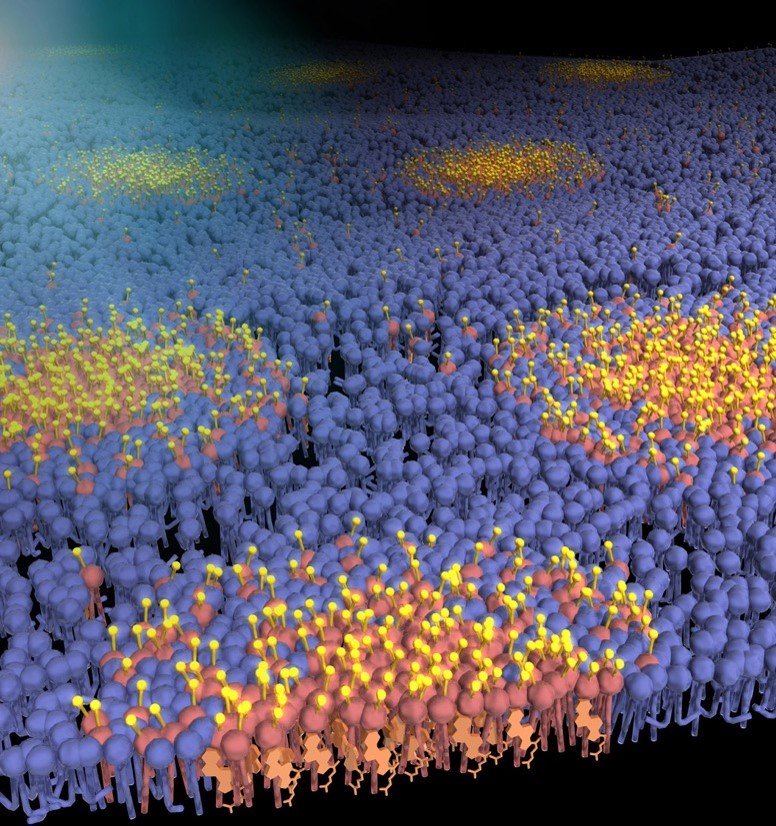Lipid rafts and neurodegeneration: structural and functional roles in physiologic aging and neurodegenerative diseases.
Grassi S, Giussani P, Mauri L, Prioni S, Sonnino S, and Prinetti A. (2020). Lipid rafts and neurodegeneration: structural and functional roles in physiologic aging and neurodegenerative diseases. Journal of Lipid Research, 61
Lipid rafts are small areas of the cell membrane rich in sphingolipids, cholesterol, and protein receptors. These structures are locations that proteins complexes interact and facilitates different physiological functions by keeping the protein receptors and their effectors in closer proximity. They also influence membrane fluidity, membrane trafficking, and neurotransmission. The components of lipid rafts are more ordered and compact than the rest of the cell membrane, but they move freely throughout the membrane. The brain in particular is very abundant with lipids, and they make up 50-60% of cell membranes in neuronal cells. As neural cells are enriched in sphingolipids, cholesterol and plasmalogens, they are perfectly suited for lipid raft formation. In particular, plasmalogens are important for maintaining stability and organization in lipid rafts. In neurons, lipid rafts are associated with a large variety of receptors for ligands such as neurotransmitters, endocannabinoids, and neurotrophins, as well as GPI-anchored receptors, tyrosine kinase receptors, adhesion molecules, and G protein-coupled receptors.
Maintaining lipid composition is an important physiological mechanism, therefore it is unsurprising that alterations to lipid metabolism and lipid raft organization are connected to neurodegenerative diseases. Genetic defects preventing enzymatic activity that leads to impairing sphingolipid degradation or loss of a protein needed for this enzymatic activity can cause an accumulation of undegraded sphingolipid in the lysosome. This issue is common in lysosomal storage diseases called sphingolipidoses. Sphingolipidoses can be diverse in the clinical manifestations but are all characterized by severe neurodegeneration. It is suggested that sphingolipids escape from the lysosome and interact with the plasma membrane and alter the organization of lipid rafts. Another example is Krabbe disease, caused by the generation of abnormal metabolites. Loss of function mutations of β-galactocerebrosidase, the enzyme responsible for degrading galactocerebrosidase to ceramide, leads to an accumulation of galactocerebrosidase (GalCer). GalCer can then be degraded to toxic levels of psychosine, causing the severe phenotype of the disease. Psychosine has been shown to accumulate in lipid rafts in the brain and sciatic nerve of human Krabbe disease patients, disrupting the lipid raft structure and displacing lipid raft proteins. In general, many other neurodegenerative diseases, such as Parkinson’s disease, Huntington’s disease, multiple sclerosis, and Alzheimer’s disease (AD), do not place lipid raft alterations as a primary causative agent in disease development, but more evidence is showing that this may have a larger role than previously thought.
Specifically looking at AD, amyloid precursor protein (APP), a transmembrane protein that often localizes to lipid rafts (although not considered a lipid raft protein), is cleaved to produce β-amyloid and other amyloid products. Accumulated β-amyloid leads to plaques and is considered to be one of the causes of the neurodegeneration in AD. APP cleavage is thought to be regulated in the lipid raft and β-amyloid production preferentially occurs in lipid rafts. In addition to β-amyloid, when APP is cleaved by γ-secretase APP intracellular C-terminus domain (AICD) is produced and further alters lipid raft organization. Adding to these effects, other proteins that are associated with an upregulation of APP cleavage are also found to be increased in AD patients, further increasing the production of β-amyloid and AICD. As well, cholesterol and sphingolipid metabolism are affected in AD; as both are significant constituents of lipid rafts. It reasons that these changes would further affect the ability of lipid raft proteins from being able to colocalize and interact.
Alterations to the lipid composition and organization in lipid rafts have been implicated in physiological aging and neurodegenerative diseases. The greatest risk factor for developing Alzheimer’s disease and other neurodegenerative diseases is increasing age. Even older individuals that do not have a neurodegenerative diagnosis also experience a decline in cognitive abilities such as mental speed, episodic memory, short-term memory, spatial memory, working memory, and the speed required to process new information. It has been demonstrated that these symptoms are often due to alterations in neuronal morphology, loss of synapses, reduced neuroplasticity, loss of cortical and hippocampal volume, and reduced dendritic branching. Driving many of these changes are alterations to membrane lipid composition, which in turn affects cell membrane structure, cholesterol processing, vesicular fusion, and lipid raft structure and function. Although changes to lipid rafts is not considered a primary driver of AD pathology, being the location where many proteins interact, it cannot be ruled out as a contributor of the disease. This also provides support for a therapeutic that targets these lipid composition alterations for treating AD.
